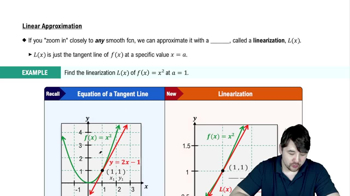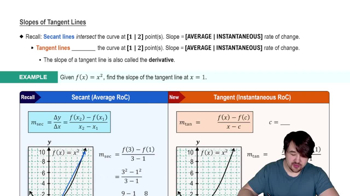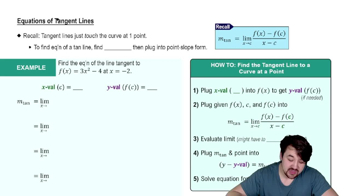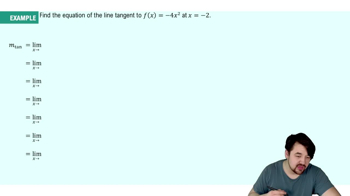Table of contents
- 0. Functions7h 52m
- Introduction to Functions16m
- Piecewise Functions10m
- Properties of Functions9m
- Common Functions1h 8m
- Transformations5m
- Combining Functions27m
- Exponent rules32m
- Exponential Functions28m
- Logarithmic Functions24m
- Properties of Logarithms34m
- Exponential & Logarithmic Equations35m
- Introduction to Trigonometric Functions38m
- Graphs of Trigonometric Functions44m
- Trigonometric Identities47m
- Inverse Trigonometric Functions48m
- 1. Limits and Continuity2h 2m
- 2. Intro to Derivatives1h 33m
- 3. Techniques of Differentiation3h 18m
- 4. Applications of Derivatives2h 38m
- 5. Graphical Applications of Derivatives6h 2m
- 6. Derivatives of Inverse, Exponential, & Logarithmic Functions2h 37m
- 7. Antiderivatives & Indefinite Integrals1h 26m
- 8. Definite Integrals4h 44m
- 9. Graphical Applications of Integrals2h 27m
- 10. Physics Applications of Integrals 2h 22m
2. Intro to Derivatives
Tangent Lines and Derivatives
Problem 3.2.43a
Textbook Question
Use the definition of the derivative to determine d/dx(ax²+bx+c), where a, b, and c are constants.
 Verified step by step guidance
Verified step by step guidance1
Step 1: Recall the definition of the derivative. The derivative of a function f(x) at a point x is given by the limit: \( f'(x) = \lim_{h \to 0} \frac{f(x+h) - f(x)}{h} \).
Step 2: Identify the function f(x) = ax^2 + bx + c. We need to find f(x+h) by substituting x with (x+h) in the function: f(x+h) = a(x+h)^2 + b(x+h) + c.
Step 3: Expand f(x+h). Use the distributive property to expand: a(x+h)^2 = a(x^2 + 2xh + h^2), and b(x+h) = bx + bh. So, f(x+h) = ax^2 + 2axh + ah^2 + bx + bh + c.
Step 4: Substitute f(x) and f(x+h) into the derivative definition: \( f'(x) = \lim_{h \to 0} \frac{(ax^2 + 2axh + ah^2 + bx + bh + c) - (ax^2 + bx + c)}{h} \).
Step 5: Simplify the expression inside the limit. Cancel out the terms ax^2, bx, and c, and then divide each remaining term by h: \( f'(x) = \lim_{h \to 0} \frac{2axh + ah^2 + bh}{h} = \lim_{h \to 0} (2ax + ah + b) \). Finally, evaluate the limit as h approaches 0.
 Verified video answer for a similar problem:
Verified video answer for a similar problem:This video solution was recommended by our tutors as helpful for the problem above
Video duration:
4mPlay a video:
Was this helpful?
Key Concepts
Here are the essential concepts you must grasp in order to answer the question correctly.
Definition of the Derivative
The derivative of a function at a point measures the rate at which the function's value changes as its input changes. Formally, it is defined as the limit of the average rate of change of the function as the interval approaches zero. This concept is foundational in calculus, as it provides a way to understand how functions behave locally.
Recommended video:

Definition of the Definite Integral
Power Rule
The power rule is a basic differentiation rule that states if f(x) = x^n, then f'(x) = n*x^(n-1), where n is a constant. This rule simplifies the process of finding derivatives for polynomial functions, making it easier to differentiate terms like ax², bx, and c in the given expression.
Recommended video:
Guided course

Power Rules
Linearity of Derivatives
The linearity of derivatives refers to the property that the derivative of a sum of functions is the sum of their derivatives, and the derivative of a constant multiplied by a function is the constant multiplied by the derivative of the function. This principle allows for the straightforward differentiation of polynomial expressions by treating each term independently.
Recommended video:

Linearization

 5:13m
5:13mWatch next
Master Slopes of Tangent Lines with a bite sized video explanation from Nick
Start learningRelated Videos
Related Practice




